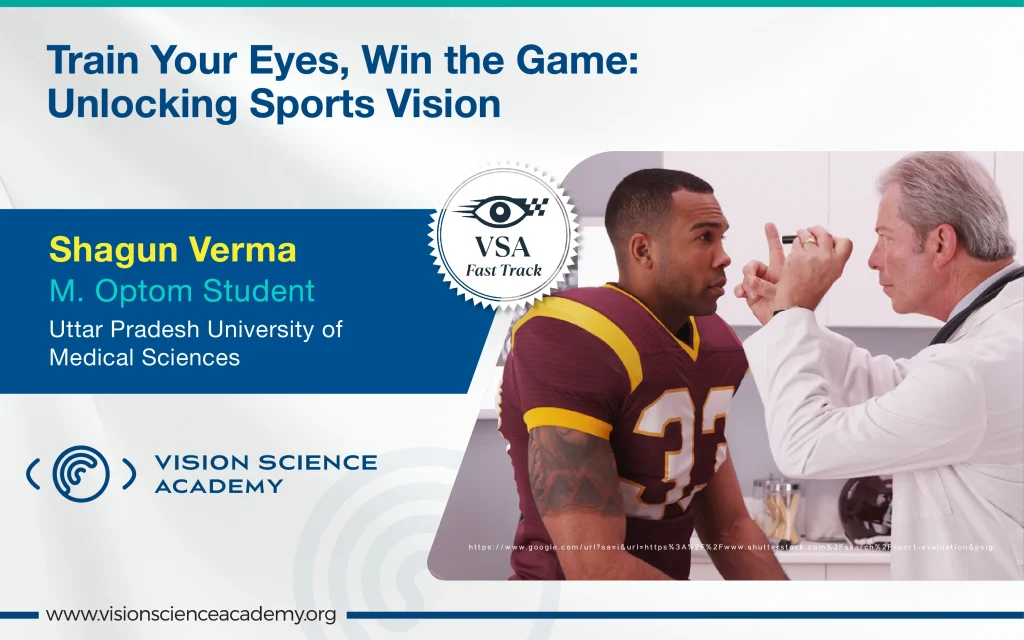Shagun Verma, B. Optom.
M. Optom Student, Uttar Pradesh University of Medical Sciences, Etawah, India
While talking about the athlete, we focus on stamina and strength, but there is one more element that plays a very important role, which is vision. It is not just how well an athlete sees on a vision chart, but how well their visual system supports performance. Let us start to talk about sports vision.
What is Sport Vision?
Sport Vision is a specialised field in optometry that helps to enhance the visual skills essential for sports performance. Athletes need more than just 20/20 eyesight. They require faster reaction times, sharp hand-eye coordination, accurate depth perception, and excellent tracking and focus. (3)
It is essential to know about this, as runners have to take care of their peripheral vision, a goalkeeper depends on rapid reaction time, and a cricketer must track a fast-moving ball. In sports, even a 0.1-second lag can cost the game. (1)
Sport Vision Testing: Measuring Visual Performance
Sport vision testing and training play an important role in enhancing sport performance by optimising visual skills which are required for various sports. Tests include Dynamic Visual Acuity, Eye-hand coordination, Depth perception, Peripheral vision, Eye tracing and pursuit, and Visual Reaction Time.
Visual Acuity measures the ability to perceive clarity of vision and small details with precision-based sports such as Archery or Shooting. Contrast Sensitivity is assessed to determine how well a sports person can see in low-light or high-glare conditions, as specifically required in night and snow sports. (4) The Dynamic Visual Acuity test helps to evaluate how clearly a sports person can see moving objects, a vital skill in fast-paced sports like Cricket, Baseball, or Hockey. (2) Depth Perception or Stereopsis helps to judge distance accurately, as is essential in games like Basketball or Tennis. Like this, other tests like Eye Tracking, Pursuit, and hand-eye coordination are also tested as required in sports like catching and throwing.
Figure 1: Sport Vision Training Process
Training the Visual System: Techniques and Tools
In training, various tools are used, such as vision therapy exercises using tools like a Brock string or accommodative flippers, which help to improve focus, convergence, and eye teaming abilities. Computer-based visual training like Dynavision or Senaptec helps to enhance visual processing speed, spatial awareness, and decision-making. Strobe glasses help to improve timing and focus, a digital reaction board for visual motor integration purposes, balance training with visual disruption to enhance visual spatial coordination, and Virtual Reality (VR) Simulators for experiencing real sport scenarios. (4) Sports vision testing and training help not only to improve reaction time and visual-motor coordination but also to enhance accuracy, reduce injury risk, and boost overall sports performance. (3)
Benefits of Sports Vision
From professional athletes to young sportspersons, anyone can enhance performance with visual training. Early screening in sports academies can help identify visual barriers before they impact growth. (1)
Conclusion
In competitive sports, vision is the hidden muscle. Training your eyes is just as crucial as training your body. Sports vision therapy unlocks your full athletic potential because when you see better, you play better.
References
- Abernethy, B. (1991). Visual search strategies and decision-making in sport. International journal of sport psychology.
- Kirschen, D. G., & Laby, D. L. (2011). The role of sports vision in eye care today. Eye & contact lens, 37(3), 127-130.
- Erickson, G. B. (2020). Sports vision: vision care for the enhancement of sports performance. Elsevier Health Sciences.
- Wilkins, L., & Gray, R. (2015). Visual Training for Sports Performance. Current Sports Medicine Reports.
- Khanal, S. (2015). Impact of visual skills training on sports performance: Current and future perspectives. Adv Ophthalmol Vis Syst, 2(1), 00032.
